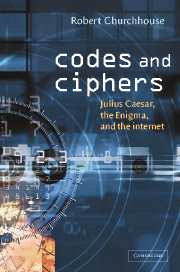Book contents
- Frontmatter
- Contents
- Preface
- 1 Introduction
- 2 From Julius Caesar to simple substitution
- 3 Polyalphabetic systems
- 4 Jigsaw ciphers
- 5 Two-letter ciphers
- 6 Codes
- 7 Ciphers for spies
- 8 Producing random numbers and letters
- 9 The Enigma cipher machine
- 10 The Hagelin cipher machine
- 11 Beyond the Enigma
- 12 Public key cryptography
- 13 Encipherment and the internet
- Appendix
- Solutions to problems
- References
- Name index
- Subject index
Preface
Published online by Cambridge University Press: 13 August 2009
- Frontmatter
- Contents
- Preface
- 1 Introduction
- 2 From Julius Caesar to simple substitution
- 3 Polyalphabetic systems
- 4 Jigsaw ciphers
- 5 Two-letter ciphers
- 6 Codes
- 7 Ciphers for spies
- 8 Producing random numbers and letters
- 9 The Enigma cipher machine
- 10 The Hagelin cipher machine
- 11 Beyond the Enigma
- 12 Public key cryptography
- 13 Encipherment and the internet
- Appendix
- Solutions to problems
- References
- Name index
- Subject index
Summary
Virtually anyone who can read will have come across codes or ciphers in some form. Even an occasional attempt at solving crosswords, for example, will ensure that the reader is acquainted with anagrams, which are a form of cipher known as transpositions. Enciphered messages also appear in children's comics, the personal columns of newspapers and in stories by numerous authors from at least as far back as Conan Doyle and Edgar Allan Poe.
Nowadays large numbers of people have personal computers and use the internet and know that they have to provide a password that is enciphered and checked whenever they send or receive e-mail. In business and commerce, particularly where funds are being transferred electronically, authentication of the contents of messages and validation of the identities of those involved are crucial and encipherment provides the best way of ensuring this and preventing fraud.
It is not surprising then that the subject of codes and ciphers is now much more relevant to everyday life than hitherto. In addition, public interest has been aroused in ‘codebreaking’, as it is popularly known, by such books and TV programmes as those that have been produced following the declassification of some of the wartime work at Bletchley, particularly on the Enigma machine.
Cipher systems range in sophistication from very elementary to very advanced.
- Type
- Chapter
- Information
- Codes and CiphersJulius Caesar, the Enigma, and the Internet, pp. ix - xPublisher: Cambridge University PressPrint publication year: 2001



